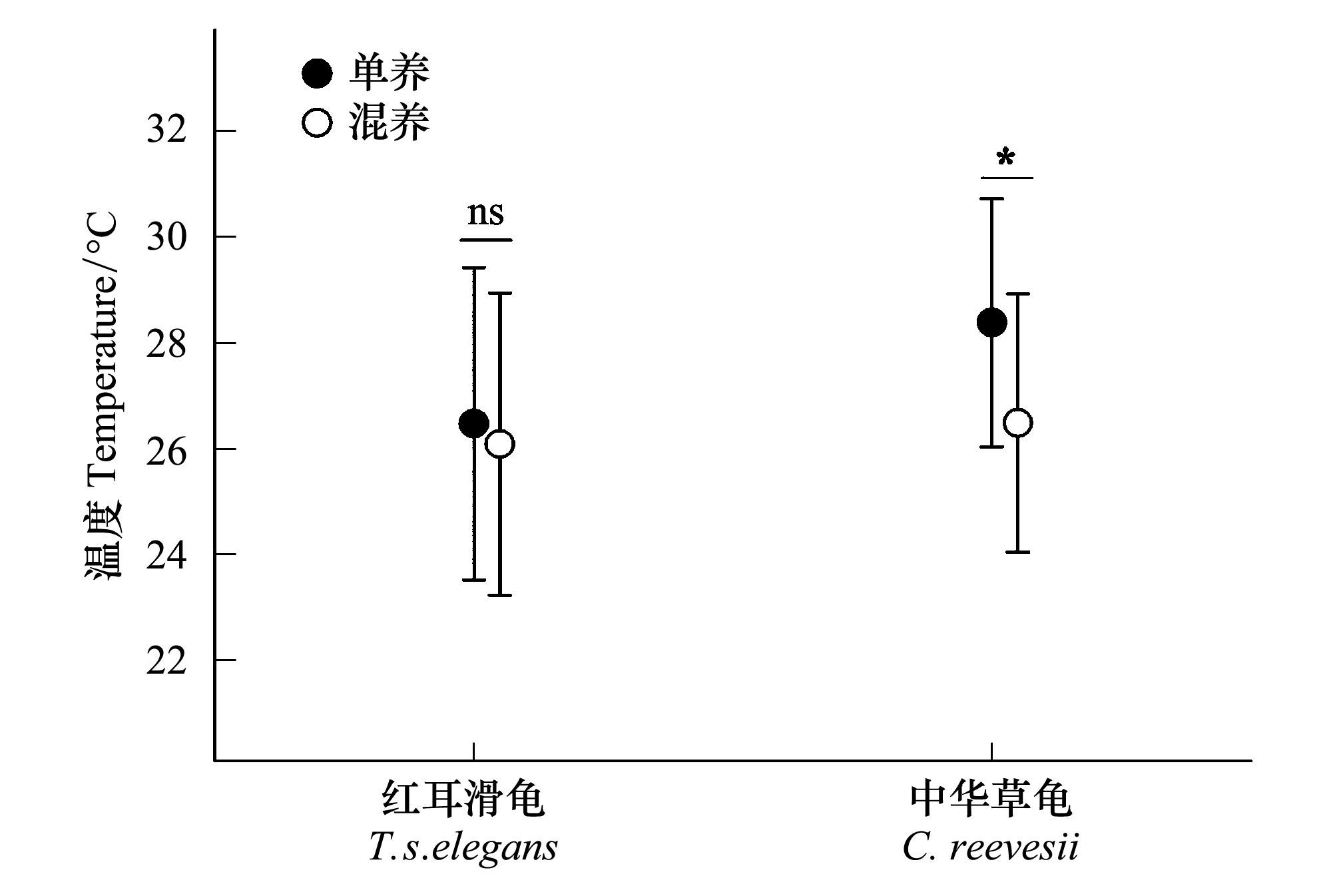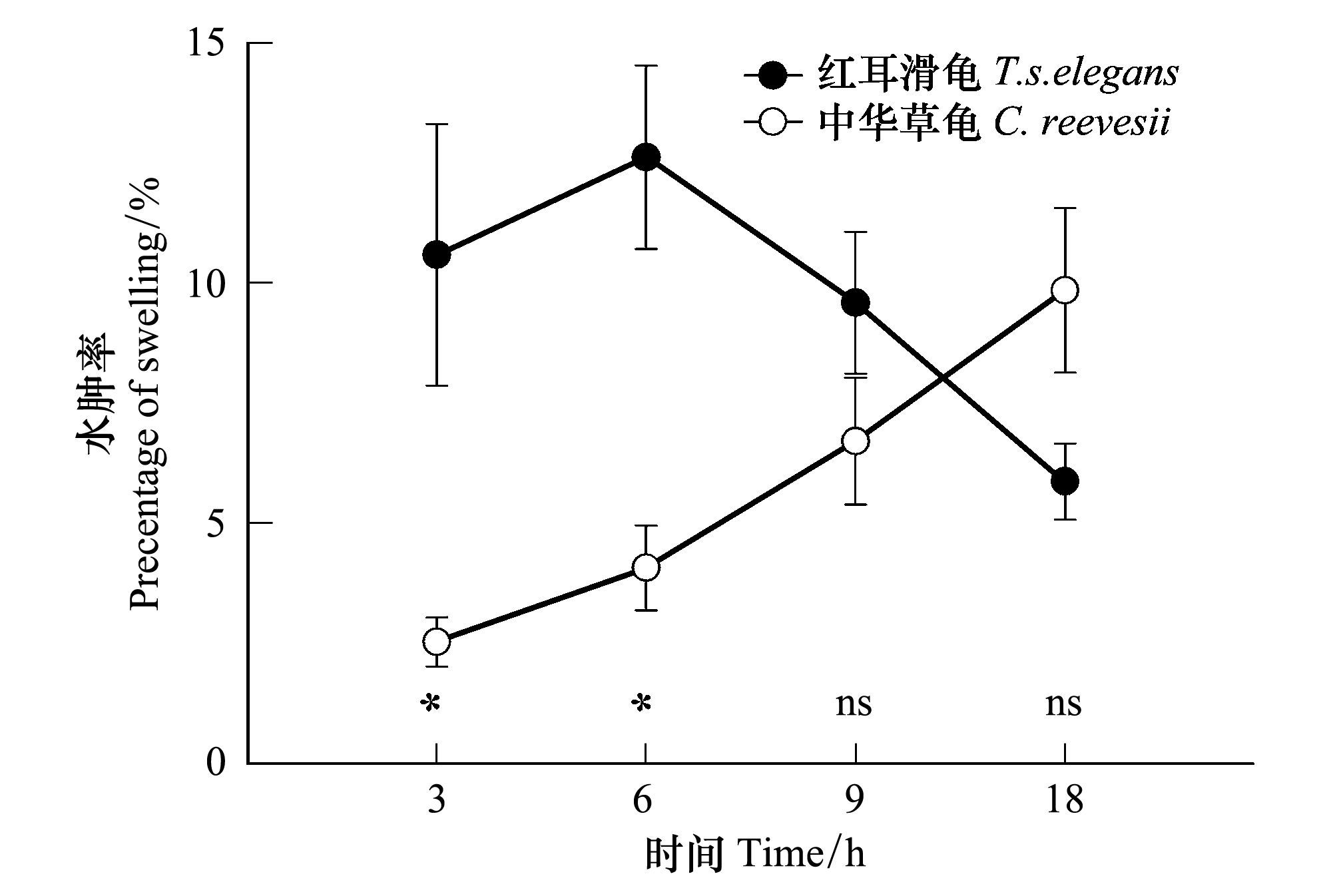文章信息
- 周赞, 蔡梦思, 刘虞, 孙燕燕, 罗来高
- ZHOU Zan, CAI Mengsi, LIU Yu, SUN Yanyan, LUO Laigao.
- 红耳滑龟和中华草龟幼体体温与运动的热依赖性、补偿生长及免疫力
- Body temperature, thermal dependence of locomotor performance, compensatory growth, and the immunity of hatchling Red-eared turtles and Chinese pond turtles
- 生态学报[J]. 2016, 36(21): 7014-7022
- Acta Ecologica Sinica[J]. 2016, 36(21): 7014-7022
- http://dx.doi.org/10.5846/stxb201502110333
-
文章历史
- 收稿日期: 2015-02-11
- 网络出版日期: 2016-03-03
2. 东营市林业局, 东营 257091;
3. 滁州学院生物与食品工程学院, 滁州 239000
2. Dongying Forestry Bureau, Dongying 257091, China;
3. College of Biology and Food Engineering Chuzhou University, Chuzhou 239000, China
外来生物入侵已成为威胁人类生态环境安全的重大社会问题,是当今世界三大环境难题之一,如何防治外来生物入侵,已成为政府和民众关注的焦点,也是学术界着力探讨的重要课题之一。我国深受外来生物入侵之害,每年造成的经济损失不可估量。据统计,我国的外来入侵生物已遍及34个省级行政区,在700多种外来入侵种中,至少有352种入侵植物、267种入侵动物和134种入侵微生物[1]。入侵形势十分严峻,解决入侵问题刻不容缓。
在众多的入侵种中,以红耳滑龟(Trachemys scripta elegans; 又名巴西龟、红耳彩龟、翠龟)造成的危害较为严重。作为世界最危险的100个入侵种之一,红耳滑龟对入侵地生态系统造成不可逆的影响,欧洲在1997年立法禁止进口红耳滑龟,试图从源头上控制该种龟的入侵危害;作为原产地的美国更是深受其害,迫使政府早在1975年就立法禁止红耳滑龟交易[2-3]。在中国台湾的基隆河,红耳滑龟作为优势种大量繁衍,大肆捕食河道内的小型鱼、贝及蛙类的卵和蝌蚪,严重破坏流域内的生态平衡。调查发现,红耳滑龟占据该流域内30%—40%的食物和空间资源,土著龟种几乎消失[4]。红耳滑龟的入侵还带来了大量的致病菌,85%室内培育个体携带副伤寒类沙门氏杆菌,并通过龟粪在水中传播扩散,感染水域附近的鸟兽,美国每年大约100—300万副伤寒类沙门氏杆菌感染病例中的14%是由红耳滑龟所引起的[5-6]。红耳滑龟还能与土著龟种杂交,对入侵地龟类遗传结构造成不可恢复的污染[7]。
已有研究显示,红耳滑龟表现如此巨大的危害与其环境适应能力强有关。在欧洲地区,该种龟具有较强的热资源争夺能力,能不断侵占土著种-地中海拟水龟(Mauremys leprosa)的热资源,提高自身晒背调温机会[8]。在相同条件下,红耳滑龟的翻身能力和食物消化能力比地中海拟水龟强[9-10]。加之圆形的体型构造使其具有较高的热惰性,能防止热量过快散失[11]。因此红耳滑龟自引入欧洲后,就得以快速适应、繁衍。红耳滑龟在污染较为严重的环境中表现为异常的适应力,能通过体内产生较多的SOD来清除环境中活性氧自由基,使机体免受活性氧伤害,土著龟-中华条颈龟(Mauremys sinensis)则因承受不了相应的污染程度而被淘汰[12]。此外,红耳滑龟具有较强的温度耐受能力[13],这也是其扩散如此广泛的原因之一。
由此可见,与土著龟类相比,红耳滑龟在入侵过程中对入侵地环境存在适应优势,其生理和行为指标均表现出一定程度的优越性,但该种龟较土著龟到底表现出多大程度的竞争优势仍缺少足够的数据。本研究以入侵种红耳滑龟和国内土著种-中华草龟(Chinemys reevesii)为对象,比较两种龟在体温调节和运动表现的热依赖性、饥饿后补偿生长以及对外源蛋白免疫能力方面的差异,探讨入侵龟对土著龟造成威胁的内在机制。
环境温度影响外温动物的体温,进而影响其生理反应和行为表现[14-15]。动物长期暴露在极端温度下可能导致死亡[16],上、下极限临界温度[临界最高温度(CTMax)和临界温度最低(CTMin)]被定义为动物不能翻身或无正常反应时的最高和最低耐受温度[17-18]。尽管外温动物可在广泛的温度下存活,但它们的生理反应和行为表现往往在适度较高的体温下更活跃,因此许多外温动物在条件允许的情况下会试图保持相对较高和稳定的体温[14, 15, 19-20]。
补偿生长是动物遭受饥饿后表现出的一种有趣的生理反应。这种反应不仅具有生理生态学意义,而且对农业生产和资源管理具有潜在的重要性。如果饥饿动物在得到充足食物后表现出快速生长冲刺并且最终赶上或超过他们一直在足够食物条件下的体重,这种补偿生长叫做完全补偿生长或过量补偿生长[21-22];如果饥饿动物虽然表现出高生长速率但最终没有赶上稳定足量饲养个体的体重,那么这种补偿生长叫做部分补偿生长[23]. 虽然已有多种动物的补偿生长被研究,例如驯养动物,鱼类,软体动物,甲壳动物等[22, 24-26],但对龟类补偿生长的研究很少,对中华鳖( Pelodiscus sinensis) 幼体补偿生长反应研究,表明中华鳖幼体在饥饿胁迫下首先利用脂肪作为主要能源以维持生存,只有完全的食物剥夺才可以诱发其部分补偿生长反应,而部分食物剥夺则不能诱发此反应[27]。
1 材料和方法 1.1 实验动物实验用3月龄及6月龄红耳滑龟和中华草龟幼体购自杭州吴山花鸟市场,其中3月龄龟用于测定体温调节、运动表现及温度耐受能力,6月龄龟用于测定补偿生长能力和免疫能力。所有动物带回实验室后,测定其形态指标,平均分至塑料整理箱中至少适应1周。随后进行常规饲养,提供足量食物,并在水体中添加钙粉和抗生素,补充因实验期间无法正常晒背而导致的钙质缺失以及减少致病菌的伤害。
3月龄红耳滑龟平均体重为(7.6±0.4) g(1SD)[N=20,范围6.8—8.5 g;平均背甲长×平均背甲宽为(32.3±0.8) ×(31.6±0.7) mm(1SD),背甲长范围:30.4—33.7 mm,背甲宽:30.1—32.7 mm]。中华草龟平均体重为(5.4±0.7) (1SD)[N=20,范围为3.9—7.1 g;平均背甲长×平均背甲宽为(28.5±1.2) ×(22.9±1.4) mm(1SD),背甲长范围:26.4—31.4 mm,背甲宽:19.8—25.5 mm]。
6月龄红耳滑龟平均体重为(25.8±3.6) g(1SD)[N=33,范围19.1—31.2 g;平均背甲长×平均背甲宽为(52.0±2.3) ×(48.0± 1.6) mm(1SD),背甲长范围:47.3—56.8 mm,背甲宽:44.8—51.0 mm],中华草龟平均体重为(30.2±3.0) g(1SD)[N=33,范围24.2—35.5 g;均背甲长×平均背甲宽为(55.4±2.1) ×(42.9±1.8) mm(1SD),背甲长范围:51.0—49.7 mm,背甲宽:40.1—47.0 mm]。
1.2 体温测定体温测定前,先将两种龟分开饲养在长×宽×高为47 cm×37 cm ×27 cm的整理箱中,用鱼缸石铺满箱底的3/4,在其上规则的放置石棉瓦,为小龟提供掩所;将整理箱移入恒温室内,调节室内最低温度为16℃,并在整理箱一侧正上方悬挂一只150 W陶瓷加热器,在箱内形成16—60℃的温度梯度。实验开始时,将幼龟从箱子的低温端释放,每个箱子放置20只龟,提供足量的食物并及时换水。幼龟适应2—3d后,用点温计(精度为0.1℃)于每天16: 00测定动物的泄殖腔温度,每只龟至少测定2d。两种龟分开饲养测定体温结束后,将其以1∶1随机混养在两个相同的整理箱中,在相同的温度环境中适应2d后,用上述相同方式测定混养后两种龟的体温。
1.3 运动表现测定根据体温测定的结果,设置20、28和36℃ 3个实验处理温度检测两种龟的运动表现。实验开始前1 h,将动物置于预设温度的恒温箱内适应,以确保动物保持恒定的目标体温;实验开始前10 min,在一长×宽为150 cm ×5 cm的带刻度泳道中注入相同温度的水,保持水深10 cm,并用点温计实时监控水温,使水温上下变动不超过0.5℃。实验开始时,将龟逐个从恒温箱内移至泳道中,一人用毛笔强烈驱赶动物(笔头频繁碰触龟的裙边,但不推动),另一人用Canon Legria HF20摄像机拍录动物在泳道内的整个运动过程。实验结束后,用会声会影软件分析动物的运动过程。用两项指标评价龟的运动表现:(1) 疾游速,指幼龟游过30 cm的最快速度;(2) 最大持续运动距离,指幼龟持续游动的最大距离。
1.4 耐受温度测定临界致死高温(CTMax)和临界致死低温(CTMin)测定在光照培养箱(宁波莱福)中进行。实验开始前,将动物放于20 cm×15 cm×8 cm的干燥塑料盒中,并移入温度预置为28℃的培养箱内适应30 min。随后,箱体温度以每20 min递增或递减2℃的速率向上或向下调节,达到培养箱的上下限温度后,通过加冰和设置白炽灯来调节温度。CTMax 和CTMin 终点的判定以动物在强烈刺激下不作出反应(不能眨眼、翻身和爬动)、移出培养箱后能逐渐恢复正常活动为标准,动物拿出后立即测量并记录泄殖腔温度。
1.5 补偿生长能力测定将30只红耳滑龟和30只中华草龟编号后随机分组,每组10只,饲养于室温(28±0.5) ℃恒温室内。3组龟分别作饥饿5、10d和15d处理,期间只提供足量饮水,并及时换水;饥饿后,足量投饲龟粮15、10d和5d。此外,再选取每种龟各3只作为对照,不进行饥饿处理,在相同的室温条件下常规饲养。测量动物实验起始和终末的体重[27],计算最后5d的体重变化率用以评价补偿生长能力,以每天每克体重变化的毫克数表示,体重变化率计算如下:体重变化率=(终末体重-初始体重)×初始体重-1×生长时间-1×1000,体重单位为g,生长时间单位为d,体重变化率单位为mg g-1 d-1。
1.6 外源性蛋白诱导的免疫反应测定实验开始前,随机选取6月龄红耳滑龟和中华草龟各10只,擦干后在干燥整理箱中适应1d,随后测定其左、右后肢脚掌厚度。配制6 mg/mL经磷酸缓冲液溶解的植物凝集素(PHA,phytohemagglutinin; Sigma),在动物的左后肢注射20 μL,右后肢注射相同剂量的磷酸缓冲液作为对照,在注药后3、6、9和18 h时测量龟脚掌的厚度。打药后,动物置于干燥整理箱中,允许其自由活动。水肿程度(水肿率)用打药前后脚掌的厚度变化值与脚掌原始厚度比值的百分数表示。
1.7 数据分析用Statistica 8.0和Sigmaplot 11.0软件包进行统计分析与作图,所有数据经正态性(Kolmogorov-Smirnov test)和方差均质性检测(F-max test)后进行参数统计分析,不符合参数统计的数据经自然兑数或三角函数转换后进行参数统计。用单因子方差分析(one-way ANOVA)检测各项指标的种间差异,用重复检验方差分析(repeated measures ANOVA)检测温度对同一物种各项生理指标的影响。实验或饲养过程中,死亡个体的数据不用于统计分析。所有描述性统计值均用平均值±标准离差表示,变异系数(coefficient of variation)用数据组的标准离差与平均值的比值乘上100来表示,显著性水平设置为α=0.05。
2 结果 2.1 体温调节两种龟分开饲养时,红耳滑龟幼体平均调节体温为26.5 ℃,最低和最高体温分别为20.1 ℃和32.9 ℃,体温调节的变异系数为11.1;中华草龟幼体平均调节体温为28.4 ℃,最低和最高体温分别为24.9 ℃和32.4 ℃,体温调节的变异系数为8.3(图 1)。两种幼龟混养时,红耳滑龟平均调节体温为26.1 ℃,最低和最高体温分别为21.8 ℃和32.9 ℃,体温调节的变异系数为10.9;中华草龟平均调节体温为26.5 ℃,最低和最高体温分别为22.2 ℃和31.5 ℃,体温调节的变异系数为9.2(图 1)。

|
| 图 1 红耳滑龟和中华草龟幼体的体温调节 Fig. 1 Body temperature regulation of hatchling T. S. elegans and C. reevesii *P < 0.05; ns无显著差异 |
单因子方差分析显示,分开饲养时,红耳滑龟和中华草龟幼体体温调节存在显著的种间差异(F1,37=4.98,P = 0.032) ;混养时,龟的体温调节不存在种间差异(F1,37=0.22,P = 0.65) 。混养显著影响中华草龟体温调节(F1,18=7.18,P = 0.015) ,但对红耳滑龟体温调节不存在影响(F1,19=0.24,P = 0.63) (图 1)。两种条件下,红耳滑龟体温调节的变异系数均大于中华草龟。
2.2 运动能力的热依赖性单因子方差分析显示,3个温度下红耳滑龟幼体的疾游速均显著大于中华草龟幼体(P<0.0001) (图 2)。重复检验方差分析显示,两种龟的疾游速均随着水温的升高而增加(P<0.002) ,但中华草龟疾游速的增幅小于红耳滑龟,且28℃和36℃下中华草龟的疾游速不存在差异(F1,15=0.29,P=0.60) 。低温和高温下,红耳滑龟的持续最大运动距离显著大于中华草龟(P<0.005) ,但28℃下,两种龟的持续最大运动距离不存在差异(P=0.51) (图 2)。重复检验方差分析显示,两种龟的持续最大运动距离随水温的升高而增加(P<0.003) ,但中华草龟的增幅小于红耳滑龟,且28℃和36℃下中华草龟的持续最大运动距离不存在差异(F1,15=0.005,P=0.95) 。

|
| 图 2 红耳滑龟和中华草龟幼体运动表现的热依赖性 Fig. 2 Thermal dependence of locomotor performance of hatchling T. S. elegans and C. reevesii |
单因子方差分析显示,中华草龟和红耳滑龟幼体的临界致死高温(F1,28=7.48,P = 0.011) 和临界致死低温(F1,28=4.38,P = 0.045) 存在明显的种间差异。其中,红耳滑龟平均临界致死高温和低温分别为41.2℃和3.6℃,中华草龟则分别为37.2℃和4.5℃(图 3),红耳滑龟的高低温耐受能力明显比中华草龟强。

|
| 图 3 红耳滑龟和中华草龟幼体的临界致死高温与低温 Fig. 3 The critical thermal maximum (CTMax) and critical thermal minimum (CTMin) of hatchling T. S. elegans and C. reevesii |
单因子方差分析显示,两种幼龟的饥饿处理组与对照组相比,均存在明显的补偿生长现象(P<0.041) 。在补偿生长阶段,饥饿5d处理的两种龟,体重变化率不存在差异(F1,16=0.03,P=0.86) ,饥饿10d处理的红耳滑龟体重变化率显著大于中华草龟(F1,15=5.12,P=0.038) ,而饥饿15d处理的中华草龟体重变化率显著大于红耳滑龟(F1,16=8.29,P=0.011) (图 4)。3种饥饿处理下的中华草龟平均体重变化率为5.6 mg g-1 d-1,变异系数为72.8;红耳滑龟的平均体重变化率为5.2 mg g-1 d-1,变异系数为24.6,红耳滑龟的体重变化率更为稳定。

|
| 图 4 恢复生长阶段中华草龟和红耳滑龟幼体的体重变化 Fig. 4 Body mass changes of hatchling C. reevesii and T. S. elegans during the compensatory growth |
两种幼龟注射植物凝集素后,左后肢均出现水肿现象。去除部分测量误差导致的无效样本,剩余12个样本用于统计分析。单因子方差分析显示,注药后3h和6h,红耳滑龟水肿程度明显要比中华草龟强( P<0.0055) ,注药后9h和18h,两者水肿程度不存在差异(P > 0.075) (图 5)。重复检验方差分析显示,红耳滑龟4个时间点的水肿程度存在显著差异(F3,15=3.70,P=0.036) ,注药后6h水肿达到最大程度,随后开始消肿;中华草龟4个时间点的水肿程度也存在显著差异(F3,15= 14.48,P=0.00011) ,随时间延长,水肿程度逐渐加强(图 5)。

|
| 图 5 植物凝集素诱导的红耳滑龟和中华草龟幼体脚掌水肿反应 Fig. 5 Phytohemagglutinin-induced swelling in the paws of hatchling C. reevesii and T. S. elegans |
本研究结果显示,从单物种分开饲养到两物种混合饲养,红耳滑龟幼体的平均调节体温不发生漂移,而中华草龟幼体的平均调节体温从28.4 ℃降至26.5 ℃,这可能与中华草龟近距离接触热源的机会下降有关。较多的体温调节机会可以使爬行动物保持最佳体温,能提高其运动能力、食物消化能力及其它生理状态。晒背机会的降低直接影响中华草龟的平均调节体温,进而降低其生理、行为表现,而红耳滑龟混养前后平均调节体温不存在差异,表明其调温机会或调温节律不发生改变。可见,在混养环境中,红耳滑龟对热资源的竞争拥有明显的优势。这与Cadi和Joly的报道类似,在红耳滑龟和欧洲泽龟(Emys orbicularis)混养的池塘中,前者占据的晒背场更多,导致后者的调温机会明显减少[28]。受红耳滑龟的影响,地中海拟水龟的晒背节律发生明显变化,该种龟往往避开与红耳滑龟同一时间点晒背,这导致其晒背时间也明显缩短[8]。
爬行动物温度耐受能力受外部因素和内部因素的影响,包括驯化环境、地理、性别、年龄和生理状态等[29-35]。高低温耐受能力影响动物的地理分布范围,低纬度种类往往具有较强的耐受高温,高纬度种类则具有较强的耐受低温[36, 37]。红耳滑龟的临界致死高温和低温分别高于和低于中华草龟,其高低温耐受幅比中华草龟宽,表明其潜在的分布范围比中华草龟广,有利于该种龟向高纬度和低纬度地区扩散。单养和混养时,红耳滑龟体温调节的变异系数均比中华草龟要大,表明红耳滑龟的体温调节幅较宽,也进一步证实其潜在的分布范围要广于中华草龟。
运动表现是影响爬行动物适合度的重要特征,受众多生理和生态因素影响[38]。爬行动物疾跑(游)速常随体温升高而加快,当体温到达一定限度时,又会随体温增加而减慢[39-41]。疾跑(游)速可以体现爬行动物的最大运动潜能,持续最大运动距离则能体现其最大运动耐力[42],这两项指标直接与野外幼龟获取食物资源和逃避天敌的能力有关[43]。本研究中,红耳滑龟和中华草龟幼体运动能力模式与中华花龟(Ocadia sinensis)[43]和中华鳖(Trionyx Sinensis)[44]幼体相似,均随体温的升高而加强。相同温度下的中华草龟相比,红耳滑龟具有更快的疾游速和更长的持续最大运动距离,因此也就具有更佳的运动潜能,在野外竞争食物和躲避天敌时,也就比中华草龟具有更多的优势。
在自然环境中,食物分布存在空间和时间异质性,动物常常在生活周期的一定阶段因食物短缺而受到饥饿胁迫[45]。耐饥饿能力高低是爬行动物能否在自然环境中维持正常存活的主要因素之一,而饥饿摄食后的补偿生长能力高低则是爬行动物迅速恢复饥饿前体能状态的重要机制,强而稳定的补偿生长能力有助于动物在食物资源多变的环境中保持稳定的生存状态[46, 47]。本研究中,尽管两种龟均存在饥饿摄食后补偿生长现象,且3种饥饿处理下两种龟的平均体重变化率相近,说明两种龟在长期饥饿后都能通过补偿生长来弥补饥饿对体重的影响,但红耳滑龟的补偿生长变异系数要明显比中华草龟小,其在饥饿不同时间后所表现的补偿生长能力相同,即具有更稳定的补偿生长能力,这有利于红耳滑龟维持较稳定的生存状态。
脊椎动物免疫能力的强弱是影响其环境适应能力的重要因素,用外源性蛋白(如植物凝集素)诱导水肿反应则是评价脊椎动物免疫能力强弱的重要技术,水肿反应越强烈,表明机体抵御外源性蛋白作用的能力越强,该技术目前已被广泛应用[48-49]。在自然环境中存在各种致病菌,爬行动物在适应环境或种间竞争过程中,往往面临各种不确定致病菌的影响,机体对抗致病菌的免疫应答能力越强,其存活几率就越大[50]。本研究中,两种龟首次注射植物凝集素,表现的是其天然免疫能力。两种龟对植物凝集素均表现出明显的免疫反应性,但红耳滑龟对植物凝集素作出的免疫反应比中华草龟要快,表明该种对外源性蛋白作出的免疫应答比中华草龟要迅速。因此,与土著种——中华草龟相比,红耳滑龟快速的免疫应答能力使其在适应环境时能保持更强的优势。
| [1] | 农业部外来入侵生物预防与控制研究中心. 中国外来入侵微生物数据库.[2012-09-08]. http://www.chinaias.cn/wjPart/SpeciesSearch.aspx?speciesType=1. |
| [2] | ISSG/SSC. 100 of the world's worst invasive species. Species, 2001, 35:5. http://www.issg.org. |
| [3] | 梁晓东, 叶万辉. 美国对入侵种的管理对策. 生物多样性 , 2001, 9 (1) : 90–94. |
| [4] | Chen T H. Distribution and status of the introduced red-eared slider (Trachemys scripta elegans) in Taiwan. Assessment and Control of Biological Invasion Risks , 2006 : 187–195. |
| [5] | Newbery R. The American red-eared terrapin in South Africa. African Wildlife , 1984, 38 : 186–189. |
| [6] | Shi H T, Parham J F, Fan Z Y, Hong M L, Yin F. Evidence for the massive scale of turtle farming in China. Oryx , 2008, 42 (1) : 147–150. |
| [7] | 徐婧, 周婷, 叶存奇, 黄成. 龟类外来种的生物入侵隐患及其防治措施. 四川动物 , 2006, 25 (2) : 420–422. |
| [8] | Polo-Cavia N, López P, Martín J. Competitive interactions during basking between native and invasive freshwater turtle species. Biological Invasions , 2010, 12 (7) : 2141–2152. DOI:10.1007/s10530-009-9615-0 |
| [9] | Polo-Cavia N, López P, Martín J. Effects of body temperature on righting performance of native and invasive freshwater turtles:consequences for competition. Physiology & Behavior , 2012, 108 : 28–33. |
| [10] | Polo-Cavia N, López P, Martín J. Aggressive interactions during feeding between native and invasive freshwater turtles. Biological Invasions , 2011, 13 (6) : 1387–1396. DOI:10.1007/s10530-010-9897-2 |
| [11] | Polo-Cavia N, López P, Martín J. Interspecific differences in heat exchange rates may affect competition between introduced and native freshwater turtles. Biological Invasions , 2009, 11 (8) : 1755–1765. DOI:10.1007/s10530-008-9355-6 |
| [12] | 张杰, 洪美玲, 廖广桥, 史海涛, 李闯, 胡茂柜. 亚硝酸盐暴露对红耳龟与中华条颈龟幼体的慢性毒性效应. 四川动物 , 2011, 30 (2) : 173–177. |
| [13] | 张永普, 潘志崇, 计翔. 红耳滑龟幼体的热耐受性、体温和运动表现热依赖性. 生态学报 , 2003, 23 (6) : 1048–1056. |
| [14] | Huey R B, Kingsolver J G. Evolution of thermal sensitivity of ectotherm performance. Trends in Ecology & Evolution , 1989, 4 (5) : 131–135. |
| [15] | Angilletta M J, Niewiarowski P H. Navas CA () The evolution of thermal physiology in ectotherms. Journal of Thermal Biology , 2002, 27 (4) : 249–268. DOI:10.1016/S0306-4565(01)00094-8 |
| [16] | Hutchison V H. The concept of critical thermal maximum. American Journal of Physiology , 1979, 237 (5) : 367–368. |
| [17] | . Doughty P Critical thermal minima of garter snakes (Thamnophis) depend on species and body size. Copeia , 1994 (2) : 537–540. |
| [18] | Lutterschmidt W I, Hutchison V H. The critical thermal maximum:history and critique. Canadian journal of zoology , 1997, 75 (10) : 1561–1574. DOI:10.1139/z97-783 |
| [19] | Huey R B. Temperature, physiology, and the ecology of reptiles//Gans C, Pough F H, eds. Biology of the Reptilia. London, 1974:25-91. |
| [20] | Navas C A, James R S, Wakeling J M, Kemp K M, Johnston I A. An integrative study of the temperature dependence of whole animal and muscle performance during jumping and swimming in the frog Rana temporaria. Comparative Biochemistry and Physiology B , 1999, 169 (8) : 588–596. |
| [21] | Paul A J, Paul J M, Smith R L. Compensatory growth in Alaska yellowfin sole, Pleuronectes asper, following food deprivation. Journal of Fish Biology , 1995, 46 (3) : 442–448. DOI:10.1111/jfb.1995.46.issue-3 |
| [22] | Hornick J L, Van Eenaeme C, Gérard O, Dufrasne I, Istasse I. Mechanisms of reduced and compensatory growth. Domestic Animal Endocrinology , 2000, 19 (2) : 121–132. DOI:10.1016/S0739-7240(00)00072-2 |
| [23] | Miglaves I, Jobling M. Effect of feeding regimens on food consumption, growth rates and tissue nucleic acid in juvenile Arctic Charr, Salvelinm alpinus, with particular respect to compensatory growth. Journal of Fish Biology , 1989, 34 (6) : 947–957. DOI:10.1111/jfb.1989.34.issue-6 |
| [24] | Russell N R, Wooton R J. Appetite and growth compensation in European minnow Phoxinus phoxinus(Cyprinidae), following short periods of food restriction. Environmental Biology of Fishes , 1992, 34 (3) : 277–285. DOI:10.1007/BF00004774 |
| [25] | Gibson Gaylord T, Gatlin D M. Assessment of compensatory growth in channel catfish Ictaluris punctatus R. and associated changes in body condition indices. Journal of The World Aquaculture Society , 2000, 31 (3) : 326–336. |
| [26] | Wu L X, Dong S L, Tian X L. The compensatory growth in the Chinese shrimp (Penaeus chinensis) following starvation. Acta Ecologica Sinica , 2001, 21 (3) : 452–457. |
| [27] | Xie Z G, and Niu C J. Effects of partial and complete food deprivation on compensatory growth of juvenile soft-shelled turtle (pelodiscus sinensis):temporal patterns in growth rate and changes in body composition. Acta Hydrobiologica Sinica , 2007, 31 (2) : 214–219. |
| [28] | Cadi A, Joly P. Competition for basking places between the endangered European pond turtle (Emys orbicularis galloitalica) and the introduced red-eared slider (Trachemys scripta elegans). Canadian Journal of Zoology , 2003, 81 (8) : 1392–1398. DOI:10.1139/z03-108 |
| [29] | Andrews R M. Geographic variation in field body temperature of Sceloporus lizards. Journal of Thermal Biology , 1998, 23 (6) : 329–334. DOI:10.1016/S0306-4565(98)00018-7 |
| [30] | Patterson J W. Emergence, basking behaviour, mean selected temperature and critical thermal minimum in high and low altitude subspecies of the tropical lizard Mabuya striata. African Journal of Ecology , 1991, 29 (4) : 330–339. DOI:10.1111/j.1365-2028.1991.tb00470.x |
| [31] | Yang J, Sun Y Y, An H, Ji X. Northern grass lizards (Takydromus septentrionalis) from different populations do not differ in thermal preference and thermal tolerance when acclimated under identical thermal conditions. Journal of Comparative Physiology B , 2008, 178 (3) : 343–349. DOI:10.1007/s00360-007-0227-7 |
| [32] | Hutchison V H. Critical thermal maxima in salamanders. Physiological Zoology , 1961, 34 (2) : 92–125. DOI:10.1086/physzool.34.2.30152688 |
| [33] | Brattstrom B H. Thermal acclimation in Australian amphibians. Comparative Biochemistry and Physiology , 1970, 35 (1) : 69–103. DOI:10.1016/0010-406X(70)90915-1 |
| [34] | Jacobson E R, Whitford W G. The effect of acclimation on physiological responses to temperature in the snakes, Thamnophis proximus and Natrix rhombifera. Comparative Biochemistry and Physiology , 1970, 35 (2) : 439–449. DOI:10.1016/0010-406X(70)90607-9 |
| [35] | Huang S P, Hsu Y Y, Tu M C. Thermal tolerance and altitudinal distribution of two Sphenomorphys lizards in Taiwan. Journal of Thermal Biology , 2006, 31 (5) : 378–385. DOI:10.1016/j.jtherbio.2005.11.032 |
| [36] | Spellerberg I F. Temperature tolerances of southeast Australian reptiles examined in relation to reptile thermoregulatory behaviour and distribution. Oecologia , 1972, 9 (1) : 23–46. DOI:10.1007/BF00345241 |
| [37] | Greer A E. Critical thermal maximum temperatures in Australian scincid lizards:their ecological and evolutionary significance. Australian Journal of Zoology , 1980, 28 (1) : 91–102. DOI:10.1071/ZO9800091 |
| [38] | Pough F H, Andrews R M, Cadle M L, Savitzky A H, Wells K D. Herpetology. Upper Saddle River NJ:Prentice Hall, 2004. |
| [39] | Ji X, Du W G, Sun P Y. Body temperature, thermal tolerance and influence of temperature on sprint speed and food assimilation in adult grass lizards, Takydromus septentrionalis. Journal of Thermal Biology , 1996, 21 (3) : 155–161. DOI:10.1016/0306-4565(95)00037-2 |
| [40] | Xu X F, Ji X. Ontogenetic shifts in thermal tolerance, selected body temperature and thermal dependence of food assimilation and locomotor performance in a lacertid lizard, Eremias brenchleyi. Comparative Biochemistry and Physiology A:Molecular & Integrative Physiology , 2006, 143 (1) : 118–124. |
| [41] | Du W G, Yan S J, Ji X. Selected body temperature, thermal tolerance and thermal dependence of food assimilation and locomotor performance in adult blue-tailed skinks, Eumeces elegans. Journal of Thermal Biology , 2000, 25 (3) : 197–202. DOI:10.1016/S0306-4565(99)00022-4 |
| [42] | 舒霖, 张群利, 屈彦福, 计翔. 青海沙蜥的热耐受性、选择体温及摄食和运动表现的热依赖性. 生态学报 , 2010, 30 (8) : 2036–2042. |
| [43] | 潘志崇, 张永普, 计翔. 中华花龟幼体的热耐受性、体温昼夜变化和运动表现的热依赖性. 动物学报 , 2003, 49 (1) : 45–52. |
| [44] | 孙平跃, 徐晓寅, 陈慧丽, 计翔. 中华鳖新孵幼体的热耐受性、体温昼夜变化和运动能力的热依赖性. 应用生态学报 , 2002, 13 (9) : 1161–1165. |
| [45] | 谢小军, 邓利, 张波. 饥饿对鱼类生理生态学影响的研究进展. 水生生物学报 , 1998, 22 (2) : 181–188. |
| [46] | 魏朝军, 杨志兵, 洪美玲, 柏天琦, 张杰, 贺斌, 史海涛. 外来种红耳龟和本地种中华条颈龟耐饥饿能力比较研究. 四川动物 , 2012, 31 (3) : 430–434. |
| [47] | 许雪峰, 吴义莲. 山地麻蜥继饥饿后的补偿生长. 动物学报 , 2002, 48 (5) : 700–703. |
| [48] | Kennedy M W, Nager R G. The perils and prospects of using phytohaemagglutinin in evolutionary ecology. Trends in Ecology and Evolution , 2006, 21 (12) : 653–655. DOI:10.1016/j.tree.2006.09.017 |
| [49] | Martin Ⅱ L B, Han P, Lewittes J, Kuhlman J R, Klasing K C, Wikelski M. Phytohemagglutinin-induced skin swelling in birds:histological support for a classic immunoecological technique. Functional Ecology , 2006, 20 (2) : 290–299. DOI:10.1111/fec.2006.20.issue-2 |
| [50] | Zimmerman L M, Paitz R T, Vogel L A, Bowden R M. Variation in the seasonal patterns of innate and adaptive immunity in the red-eared slider (Trachemys scripta). The Journal of Experimental Biology , 2010, 213 (9) : 1477–1483. DOI:10.1242/jeb.037770 |
 2016, Vol. 36
2016, Vol. 36




